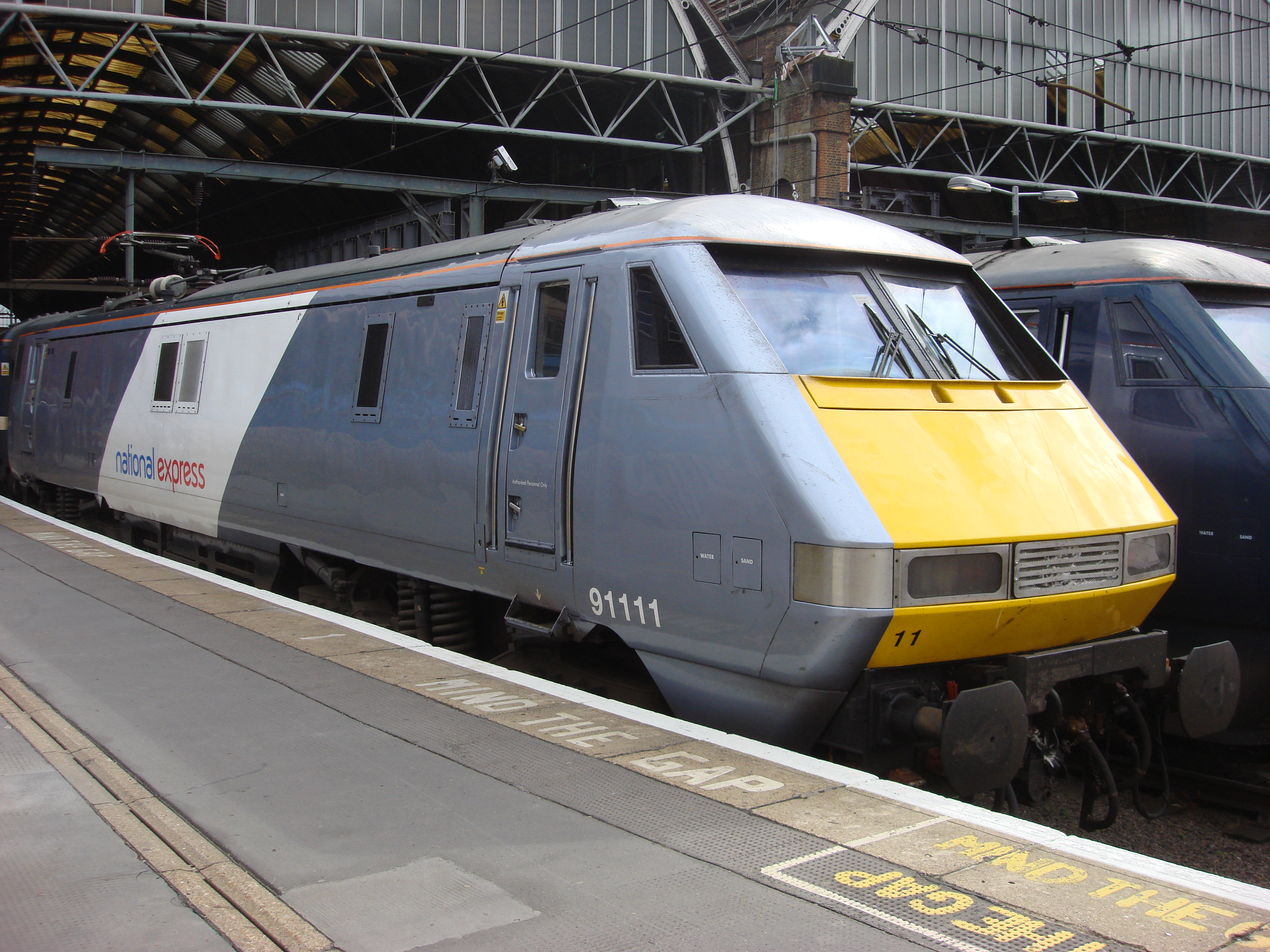- British Rail Class 91
Infobox Locomotive
name = British Rail Class 91
powertype = Electric
caption = 91111 at King’s Cross station, London
builder =BREL
builddate = 1988–1991
totalproduction = 31
gauge = RailGauge|sg|lk=on|al=on
tractionmotors =
electricsystem =25 kV AC
collectionmethod = Pantograph
whytetype =Bo-Bo
uicclass = Bo'Bo'
trainbrakes = Air
locobrakes = Air
locobrakeforce = convert|45|LTf|kN|abbr=on|lk=in
length = convert|63|ft|8|in|m|2|abbr=on
width =
height =
weight = convert|84|t|lk=on
topspeed = "Design:" convert|140|mph|km/h|abbr=on|lk=on
"Service:" convert|125|mph|km/h|abbr=on|lk=on
poweroutput =
tractiveeffort =
railroad =British Rail GNER National Express East Coast
roadnumber = 91001–91031; later 91101–91122, 91124-91132TheBritish Rail Class 91 is a class of 140 mph, 6,300 hpelectric locomotive s ordered specifically for theEast Coast Main Line modernisation and electrification programme of the late 1980s. Built to replace the previous Class 43 (better known as theInterCity 125 ), the Class 91s were given the auxiliary name ofInterCity 225 to indicate their status as a new version of the 125 and their envisaged top speed of 225km/h (140mph). The other end of theInterCity 225 train set is formed of aDriving Van Trailer , built with a similar bodyshell to the Class 91 locomotives.History
The Class 91 fleet was built in two batches, the first 10, then the remaining 21, between 1988 and 1991 at
BREL ,Crewe under subcontract fromGEC to work with Mark 4 coaches. At the time the Class 91s were branded by British Rail as the 'Electra'. Derived from power cars of the ill-fatedAdvanced Passenger Train , a power supply to allow the Mark 4 Coaches to tilt was provided but was removed during their recent rebuild.One initial idea was to use these locomotives on fast passenger services in the day, and on intermodal trains at night. These plans were dropped and freight workings left to the Class 90s.
The Class 91s began passenger service on March 3rd 1989 when 91001 worked 1P26 17.36 London Kings Cross to Peterborough train.This train was formed of InterCity 125 Mark 3 coaches and a power car converted for use as a DVT as the Mark 4 coaches were not yet ready. The class 91s then began service on Kings Cross to Leeds trains on 11th March 1989 when 91008 with a rake of Intercity 125 Mark 3 coaches and power car 43068 worked the 1D32 06:50 Kings Cross to Leeds service. The set then worked 1A12, the 10.00 Leeds to Kings Cross service. On this service the guard made an announcement whilst descending Stoke Bank that this was the location where Mallard reached its world record speed of 126mph going down but this morning this Electra train had gone up the bank at 140mph.
In the early 1990s, after the Treasury failed to support funding for the IC250,
British Rail examined the option of ordering a further set of Class 91s to operate on theWest Coast Main Line . Limited funding meant that the procurement of the Class 465 EMU Networker stock was taken forward instead of these.The asymmetric body style is streamlined at one end to allow high speed operation with the fixed sets of Mark 4 coaches in push-pull operation. An additional requirement of the design was that they could operate as normal locomotives. This led to a second cab being incorporated into the 'flat end'. [ [http://www.flickr.com/photos/mattingham/215446151/ 'mattingham' - GNER Class 91 driving flat-end first] ]
The fleet, previously operated by InterCity and then
GNER (Great North Eastern Railway), is now operated under lease fromHSBC Rail byNational Express East Coast , owners of the ECML franchise post privatisation, and underwent a refit between 2000 and 2003 to improve reliability. This has resulted in the renumbering of the fleet from 910XX to 911XX, with the exception of locomotive 91023 "City of Durham", which had been involved in the rail crashes at Hatfield and Selby. The locomotive escaped with minor damage on both occasions, but it was renumbered to 91132 (instead of the expected 91123) to avoid suggestions that it had "bad luck". [cite book
last = Pritchard, Fox & Hall
first =
title = British Railways Locomotives & Coaching Stock 2007
publisher = Platform 5 Publishing Ltd.
date = 2007
location = Sheffield, UK
ISBN = 9781902336558 ]A Class 91 , 91010 (now 91110) holds the British locomotive speed record at 162 mph, set on September 17th 1989 ,just south of Little Bytham on a test run down
Stoke Bank with the DVT end leading. Although both Class 370s and Class 373s have run faster, both types are EMUs, which means that the "Electra" is officially the fastest locomotive in Britain. Another loco, hauling five Mk4s and a DVT, once ran betweenLondon King's Cross and Edinburgh Waverley in 3 hours, 29 minutes and 30 seconds, still the current record. She covered the route in an average speed of 112.5 mph, and reached the full 140 mph several times during the run. When introduced, they were also the most powerful locomotive in Britain.Livery
When British Rail was privatised, the white Intercity livery was progressively removed. New operator GNER applied their corporate livery of blue and red of GNER. When GNER lost their franchise in 2007, the red stripe was replaced by white masking tape. National Express East Coast plan to re-livery all of their Intercity 225s in the next two years. This encompasses the complete removal of the dark blue livery in favour of the white and silver NX corporate livery.
The trainsets had the nicknames "Stealth Bombers" due to the deep blue colour of the livery. But this has ended now. They have also been described as
dung beetle s by some enthusiasts - an allusion to their opinion of the Mark 4 rolling stock. [Citation
last =
first =
title = ukrailwayfaq » Rolling Stock Nicknames
url=http://ukrailwayfaq.wikispaces.com/Rolling+Stock+Nicknames
accessdate = ]Gallery
See also
*
InterCity 225
*InterCity (British Rail)
* Class 93External links
* [http://www.traintesting.com/IC225.htm Testing the Intercity 225/Class 91]
* [http://www.thejunction.org.uk/flist_91.html Class 91 fleet list on www.thejunction.org.uk]References
Wikimedia Foundation. 2010.
